Shopify's FCF Margins Could Push It Higher
Shopify Inc. (NYSE:SHOP) is an online shop and product-selling platform based in Canada. It is growing quickly and has been increasingly profitable. As a result, the stock is worth considerably more.
My price target is 31% higher than today's price.

Strong fundamentals
Shopify has generated positive free cash flow for the past six quarters. Free cash flow is the cash the company generates after covering all of its cash expenses, capital expenditure spending and any net changes in working capital.
On May 8, the company reported that its FCF was $232 million for the quarter ending March 31. That was 170% greater than the $86 million FCF it made in the prior-year quarter.
In addition, its FCF margin was 12.50% versus 5.70% last year.
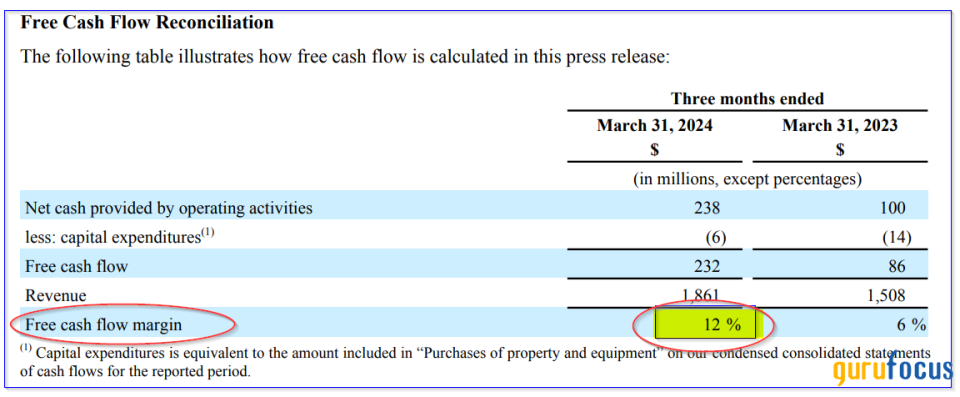
In fact, Shopify has a much higher free cash flow margin than Amazon.com Inc. (NASDAQ:AMZN).
The company generated over $1.05 billion in FCF on $7.41 billion in sales in the trailing 12 months ending in the first quarter. That works out to a 14.20% trailing 12-month FCF margin.
This was much higher than Amazon's 8.40% trailing 12-month FCF margin for the same period (i.e., $50 billion/ $590.4 billion in trailing 12-month revenue).
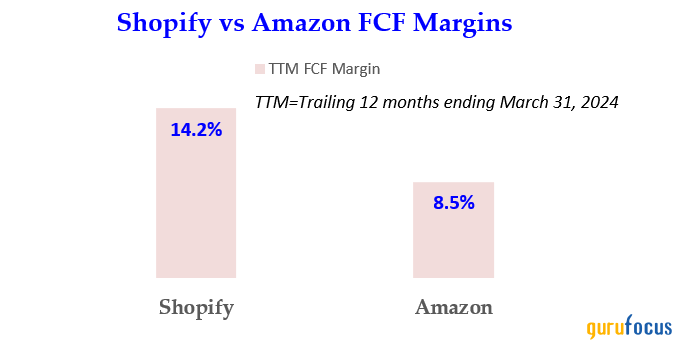
However, the market did not like Shopify's recent results and the stock pulled back. One reason was the company's FCF margin of 12.50% was lower than the prior quarter's 20.80% FCF margin.
The bottom line is this provides a good value buying opportunity.
Strong revenue and FCF growth leads to an opportunity
Shopify has been on a very fast growth trajectory. For example, its revenue in the first quarter was up 23.40% year over year. Moreover, free cash flow was up 170%. But on a quarter-over-quarter basis, sales and FCF were lower. That lowered its FCF margin from 20.80% to 12.50%.
This can be seen in the chart below, which shows this quarter's lower revenue and FCF.
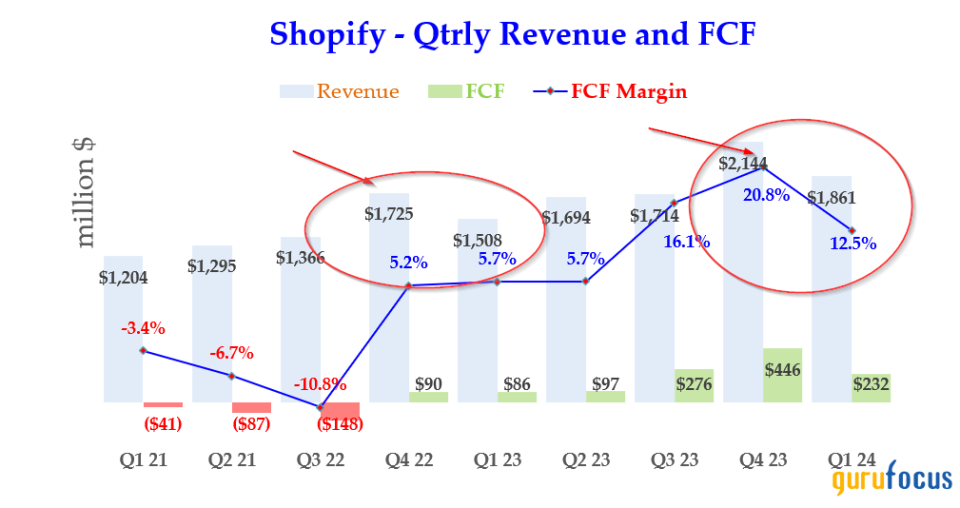
Revenue fell from $2.14 billion to $1.86 billion. As a result, Shopify's stock has fallen recently. However, you can see in the chart above the first-quarter sales in 2023 were lower after the higher fourth-quarter 2022 Christmas quarter.
So investors should look at the trailing 12 months figures to wring out seasonal fluctuations. Here is how that looks on a trailing 12-month basis.
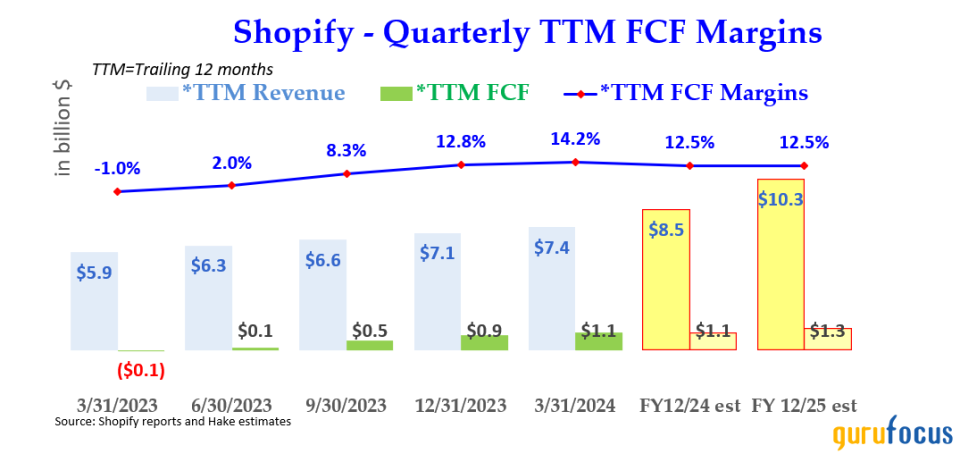
This is a different picture. It shows that over the trailing 12 months each quarter, the company's FCF has been growing and its FCF margins have been higher.
For example, its trailing 12-month FCF margin was 14.20% in the first quarter and that was higher than the prior quarter's trailing 12-month FCF margin of 12.80%.
So the market's disappointment is misplaced. This leads to a buying opportunity for value investors.
Moreover, even if we use a 12.50% FCF margin going forward, the company will generate $1.06 billion in FCF in 2024. That is based on analysts' estimates of $8.49 billion in revenue for 2024.
That will be 17% higher than the $910 million it generated last year.
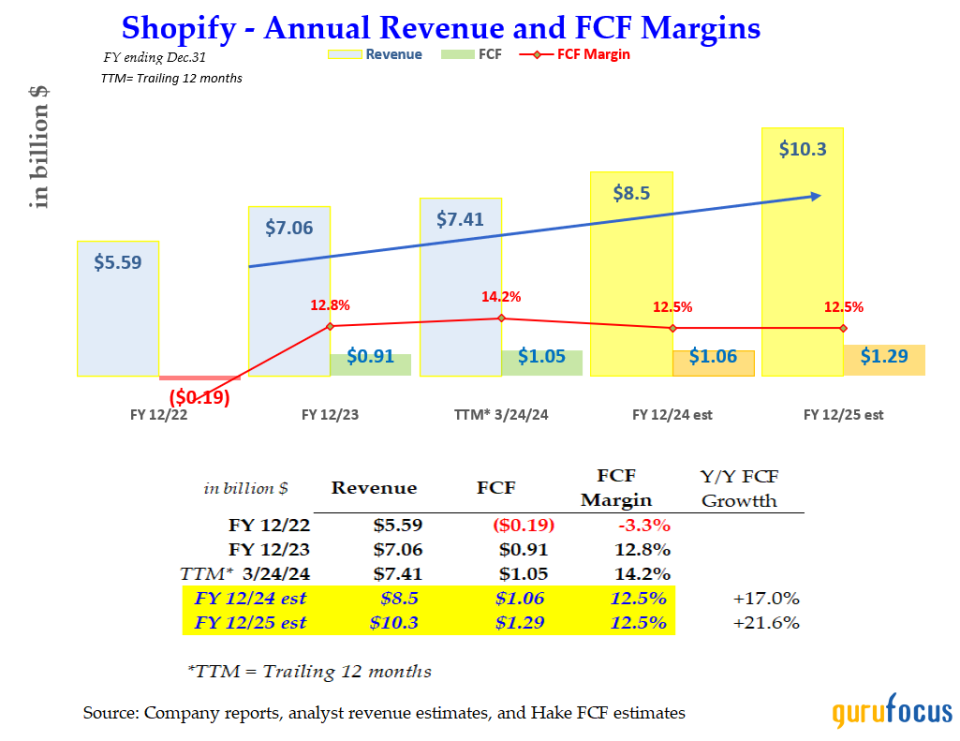
Moreover, next year FCF could be 21.60% higher using analyst revenue estimates of $10.30 billion and a 12.50% FCF margin.
The bottom line is investors can expect to see strong FCF going forward. In fact, management indicated this in its outlook section of the earnings report:
Free cash flow margin to be similar to Q1 2024 free cash flow margin. We have now delivered three consecutive quarters of double-digit free cash flow margin, with no expectation for this trend to change.
This can lead to a higher target price for Shopify's stock.
Valuing Shopify
The easiest way to value the stock using this information is to use an FCF yield metric. That assumes that if all of the company's free cash flow was used to pay a dividend, its dividend yield can be used to set its market value.
For example, let's assume that all of the estimated $1.06 billion Shopify makes in 2024 is paid out as a dividend to investors.
Given that Shopify is on a growth trajectory and similar stocks like Meta Platforms (NASDAQ:META) and Alphabet (NASDAQ:GOOG) have a dividend yield lower than 1%, we can use a 1% FCF yield metric:

This shows the estimated market cap using a 1% FCF yield (or 100 times FCF) is $117 billion, which is 46% higher than its $81 billion market cap today. That leads to a target price of $91 per share.
But just to be slightly more conservative, let's use a 1.25% FCF yield metric (i.e., 80 times FCF).

The projected market cap is $94 billion, or 16.5% higher, at a target price of $72.79 per share. The average of both of these is a $106 billion market cap.
This implies the average price target is $81.88, or 31% higher than today's price of $62.48.
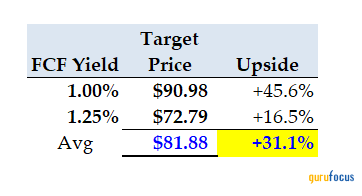
Shorting OTM puts to set a buy-in price
One way to take advantage of the market weakness in Shopify is to sell short out-of-the-money put options in nearby expiry periods. That way, the investor can make extra income while waiting for the stock to fall further and set a good buy-in price.
For example, look at the May 31, 2024 put options expiration period, which is a couple weeks away. It shows the $60 strike price puts, which is over 4% below the current price, trade for $1.01 per contract.
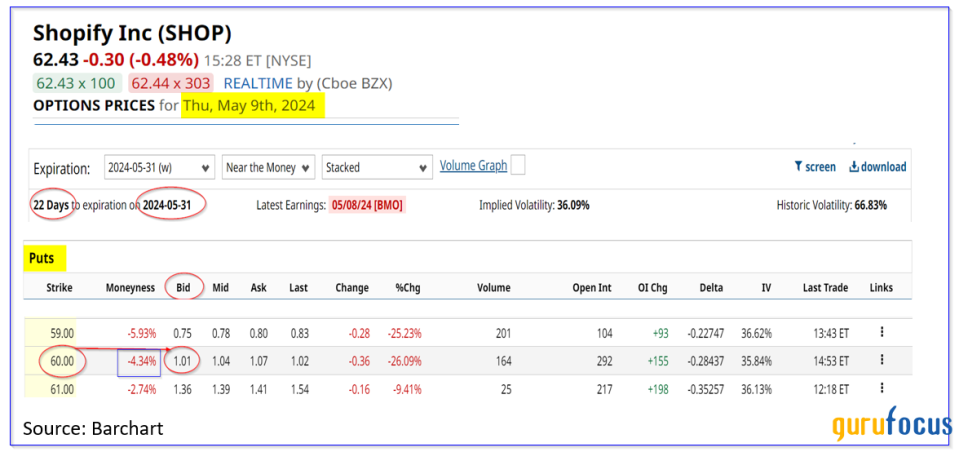
That means the investor who secures $6,000 with their brokerage firm can enter an order to Sell to Open one put contract at this strike price. Their account will immediately receive $101. That way, their yield is $101/$6,000, or 1.68% over the next couple of weeks.
Moreover, the breakeven price is $60 minus $1.01, or $58.99. This is 5.47% below the price of $62.41 at the time of writing.
In other words, the investor will not have an unrealized capital loss unless the stock falls almost 5.50% in the next few weeks. Meanwhile, they get to keep the $101 and the 1.68% yield no matter what.
In fact, over the next quarter that works out to an expected return of 6.73% (i.e., $404/$6,000). This assumes the short-put yield play can be repeated four times at the same yield level.
The bottom line is Shopify is very cheap here. By shorting OTM puts, investors can set a price target to buy in and gain extra income.
This article first appeared on GuruFocus.

 Yahoo Finance
Yahoo Finance 